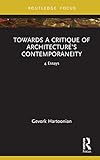Towards a critique of architecture's contemporaneity
Par: Gevork, Hartoonian.
Type Document : Ouvrage Editeur: Abingdon , New York Routledge focus 2023Description Matérielle: 144 Couv,ill en noire,tab,cartes 14x22cm.ISBN: 9781032418681.Mots Clés: Architecture - Philosophie | Théorie de l'architectureRésumé: Pursuing historical analogies between nineteenth-century theories and the current practices captivated by digital reproducibility, this book offers a critical take on architecture's contemporaneity through four essays: tectonics, materiality, cladding, and labor. Fundamental to this proposition is the historicity of Gottfried Semper's theorization of architecture amidst the outpouring of new materials and construction techniques during the 1850s. Starting with Semper's differentiation between theatricalization and the tectonic of theatricality, this book closely examines thematic essential to architecture's self-representation. Even though the title of this book recalls the Semperian four elements of architecture, its argument encapsulates a unique historico-theoretical project probing the tectonic of theatricality beyond Semper. The invisible tie between technique and labor is the cord running through the four subjects covered in this book. In exploring these subjects from the theoretical standpoint of Marxian dialectics, this book's contribution is focused on, but not limited to, the topicality of labor today when its relationship with capital has been further obscured by the prevailing digitalization of commodity exchange value, starting roughly in the 1990s. Each essay examines Semper's theorization of architecture in contradistinction to the ways in which technology's mediation has dominated architecture's representation. Burrowing through the invisible tie between technique and work, asymptomatic of architecture's predicament in global capitalism, this book advances the scope of architectural criticism beyond the exhausted formalism and architecture's turn to philosophy circa the 1980s and the present tendencies for presentism. It will therefore be of interest to researchers and students of architectural history and theory.Sommaire:| Type de document | Site actuel | Cote | Statut | Notes | Date de retour prévue | Code à barres | Réservations |
|---|---|---|---|---|---|---|---|
 Ouvrage
Ouvrage
|
Bibliothèque Centrale
|
08040411001 (Parcourir l'étagère) | Disponible | 8.2 | 08040411001 | ||
 Ouvrage
Ouvrage
|
Bibliothèque Centrale
|
08040411002 (Parcourir l'étagère) | Disponible | 8.2 | 08040411002 |
Pursuing historical analogies between nineteenth-century theories and the current practices captivated by digital reproducibility, this book offers a critical take on architecture's contemporaneity through four essays: tectonics, materiality, cladding, and labor. Fundamental to this proposition is the historicity of Gottfried Semper's theorization of architecture amidst the outpouring of new materials and construction techniques during the 1850s. Starting with Semper's differentiation between theatricalization and the tectonic of theatricality, this book closely examines thematic essential to architecture's self-representation. Even though the title of this book recalls the Semperian four elements of architecture, its argument encapsulates a unique historico-theoretical project probing the tectonic of theatricality beyond Semper. The invisible tie between technique and labor is the cord running through the four subjects covered in this book. In exploring these subjects from the theoretical standpoint of Marxian dialectics, this book's contribution is focused on, but not limited to, the topicality of labor today when its relationship with capital has been further obscured by the prevailing digitalization of commodity exchange value, starting roughly in the 1990s. Each essay examines Semper's theorization of architecture in contradistinction to the ways in which technology's mediation has dominated architecture's representation. Burrowing through the invisible tie between technique and work, asymptomatic of architecture's predicament in global capitalism, this book advances the scope of architectural criticism beyond the exhausted formalism and architecture's turn to philosophy circa the 1980s and the present tendencies for presentism. It will therefore be of interest to researchers and students of architectural history and theory.

